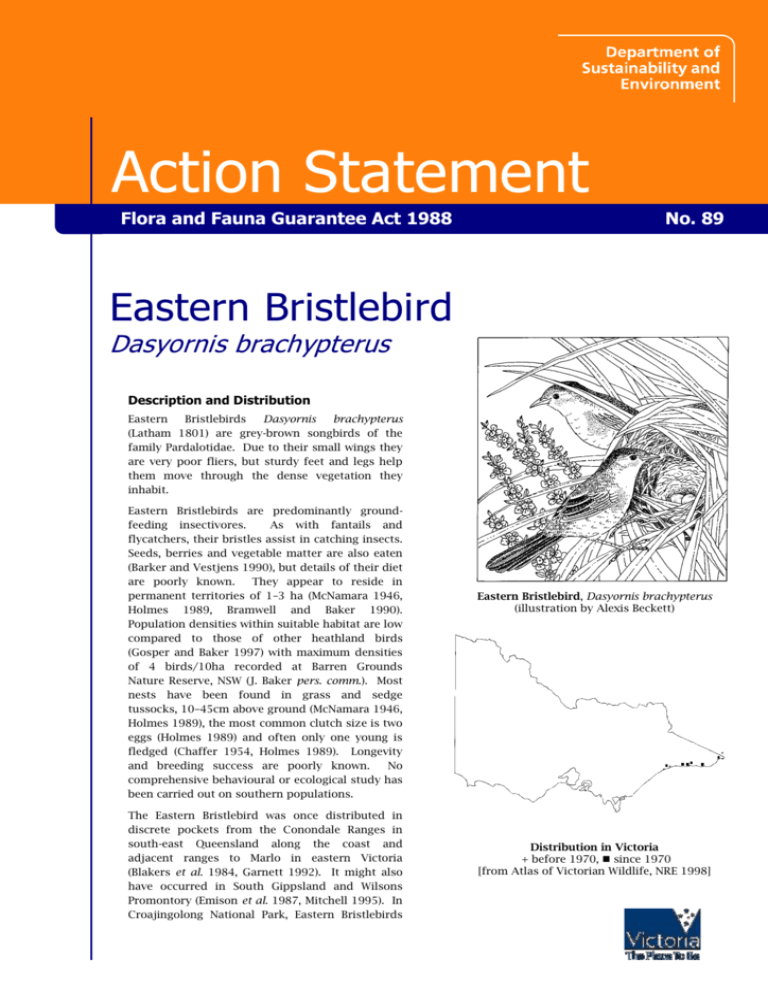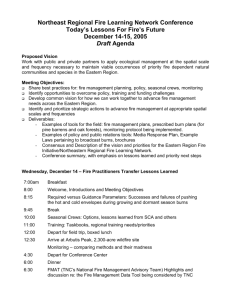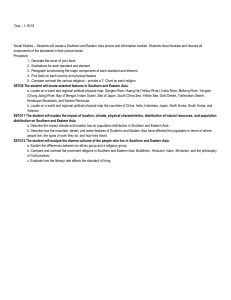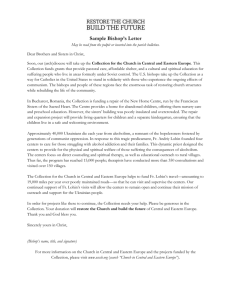Eastern Bristlebird (Dasyornis brachypterus) accessible
advertisement

Action Statement Flora Floraand andFauna FaunaGuarantee GuaranteeAct Act1988 1988 No.No. ### 89 Eastern Bristlebird Dasyornis brachypterus Description and Distribution Eastern Bristlebirds Dasyornis brachypterus (Latham 1801) are grey-brown songbirds of the family Pardalotidae. Due to their small wings they are very poor fliers, but sturdy feet and legs help them move through the dense vegetation they inhabit. Eastern Bristlebirds are predominantly groundfeeding insectivores. As with fantails and flycatchers, their bristles assist in catching insects. Seeds, berries and vegetable matter are also eaten (Barker and Vestjens 1990), but details of their diet are poorly known. They appear to reside in permanent territories of 1–3 ha (McNamara 1946, Holmes 1989, Bramwell and Baker 1990). Population densities within suitable habitat are low compared to those of other heathland birds (Gosper and Baker 1997) with maximum densities of 4 birds/10ha recorded at Barren Grounds Nature Reserve, NSW (J. Baker pers. comm.). Most nests have been found in grass and sedge tussocks, 10–45cm above ground (McNamara 1946, Holmes 1989), the most common clutch size is two eggs (Holmes 1989) and often only one young is fledged (Chaffer 1954, Holmes 1989). Longevity and breeding success are poorly known. No comprehensive behavioural or ecological study has been carried out on southern populations. The Eastern Bristlebird was once distributed in discrete pockets from the Conondale Ranges in south-east Queensland along the coast and adjacent ranges to Marlo in eastern Victoria (Blakers et al. 1984, Garnett 1992). It might also have occurred in South Gippsland and Wilsons Promontory (Emison et al. 1987, Mitchell 1995). In Croajingolong National Park, Eastern Bristlebirds Eastern Bristlebird, Dasyornis brachypterus (illustration by Alexis Beckett) Distribution in Victoria + before 1970, since 1970 [from Atlas of Victorian Wildlife, NRE 1998] have been recorded from dense heath, melaleuca thickets, rainforest along creeks and lowland forest dominated by Red Bloodwood (Dorwood 1976, Emison et al. 1987, C. Meredith pers. comm.). In the Bemm River – Marlo area they inhabited thick, lower stratum vegetation of coastal dune scrub and riparian scrub close to heathland. Other records were from warm temperate rainforest and riparian forest (Clarke and Bramwell 1998, Bramwell et al. 1993). Reserve in NSW and at Howe Flat in Croajingolong National Park, Victoria. Only six remaining populations are known: two near Brisbane, two near Wollongong and two (possibly one) adjacent to the NSW–Victoria border near Cape Howe. Southern populations near Cape Howe have been recorded in Nadgee Nature Reserve in NSW and at Howe Flat in Croajingolong National Park, Victoria. Major Conservation Objective Conservation Status Current status Australia: Endangered (ESP Act 1992a) Queensland: Critically Endangered (Nature Conservation (Wildlife) Regulation 1994) Victoria: Endangered (NRE 1999); Threatened (FFG Act) New South Wales: Endangered (Threatened Species Conservation Act 1995)................ The Eastern Bristlebird has been listed as a threatened taxon on Schedule 2 of the Flora and Fauna Guarantee Act 1988. Reasons for conservation status The Eastern Bristlebird was once distributed in discrete pockets from the Conondale Ranges in south-east Queensland along the coast and adjacent ranges to Marlo in eastern Victoria (Blakers et al. 1984, Garnett 1992). It might also have occurred in South Gippsland and Wilsons Promontory (Emison et al. 1987, Mitchell 1995). In Croajingolong National Park, Eastern Bristlebirds have been recorded from dense heath, melaleuca thickets, rainforest along creeks and lowland forest dominated by Red Bloodwood (Dorwood 1976, Emison et al. 1987, C. Meredith pers. comm.). In the Bemm River – Marlo area they inhabited thick, lower stratum vegetation of coastal dune scrub and riparian scrub close to heathland. Other records were from warm temperate rainforest and riparian forest (Clarke and Bramwell 1998, Bramwell et al. 1993). Only six remaining populations are known: two near Brisbane, two near Wollongong and two (possibly one) adjacent to the NSW–Victoria border near Cape Howe. Southern populations near Cape Howe have been recorded in Nadgee Nature The Scientific Advisory Committee (SAC 1994) has determined that the Eastern Bristlebird is: significantly prone to future threats which are likely to result in extinction, very rare in distribution terms of abundance or The major conservation objective is to prevent further fragmentation and decline in population density. This will be accomplished by: clarifying the distribution and abundance of Eastern Bristlebird in Victoria within three years. identifying the major threatening processes and ecological requirements of the southern population of the species within five years. minimising the impact of these threatening processes by developing appropriate fire regimes and commencing predator control. Management Issues Ecological issues specific to the taxon Little is known of the population size, the essential components of suitable habitat, breeding success, optimum fire regime, effects of predation, dispersal among populations, factors limiting the size of existing populations and genetic variation among populations. It appears that populations occur largely near the boundaries between vegetation communities. The main threat to the species in Victoria appears to be fire, especially frequent wildfires. In northern and central populations Eastern Bristlebirds have been reported to recolonise areas of burnt habitat (Lamb et al. 1993, Jordan 1984). However, the thick ground layer needed for nesting and breeding develops only if fires are neither too frequent nor too infrequent (Holmes 1989, Baker 1997). No information exists on appropriate fire regimes for Victorian populations of Eastern Bristlebird. Holmes (1989) recommends a fire frequency of 10 to 20 years for northern populations of Eastern Bristlebirds. In Barren Grounds Nature Reserve, Bramwell et al. (1993) recorded a higher Eastern Bristlebird density in ecotonal areas nine years after fire than in similar areas that were last burnt 6.5 years ago. In Western Australia, the heath may take eight to ten years to regenerate after a fire to a suitable stage for the congeneric Western Bristlebird (Smith 1977). 2 Feral Cats Felis catus and Red Foxes Canis vulpes are likely to be important predators because Eastern Bristlebirds are ground-dwelling. Cats appear to be the main feral predator in northern populations of Eastern Bristlebirds (Hartley and Kikkawa 1994). Anecdotal evidence suggests predation is high within the Howe Flat population; in three short visits to the area, the remains of two Eastern Bristlebirds were found (Clarke and Bramwell 1998). Wider conservation issues Eastern Bristlebird habitat is important for a range of other threatened flora and fauna, notably the rare Smoky Mouse Pseudomys fumeus, Ground Parrot Pezoporus wallicus, Turquoise Parrot Neophema pulchella, Masked Owl Tyto novaehollandiae, King Quail Coturnix chinensis and Swamp Skink Egernia coventryi, the insufficiently known Martin’s Toadlet Uperoleia martinii, Tyler's Toadlet Uperoleia tyleri and Glossy Grass Skink Leiolopisma rawlinsonii and the vulnerable She-oak Skink Cyclodomorphus casuarinae, Diamond Python Morelia spilota spilota, Tartan Tongueorchid Cryptostylis erecta and the Leafless Tongueorchid Cryptostylis hunteriana. These species will need to be considered in the development of management actions, especially fire regimes. The management plan for Croajingolong National Park (NRE 1996) and the fire management plan for coastal heathland in far east Gippsland (Avis 1993) might need to be amended when further information about the species is obtained. data and management recommendations have been summarised for Jervis Bay National Park (Baker & Whelan 1996). The Croajingolong National Park Management Plan (NRE 1996) recognises the importance of Howe Flat for Eastern Bristlebirds and outlines management actions for this area, including fire management. Intended Management Action The following actions are intended for NRE staff in the Gippsland Region in conjunction with Flora and Fauna Program, bird conservation organisations and volunteers and should form part of any National Recovery Plan for the species. Recovery Team 1. Survey 2. 3. Northern populations have been surveyed, and ecological research has been conducted in the Border Ranges (Holmes 1989, Lamb et al. 1993, Hartley and Kikkawa 1994). A genetic study and further ecological study of the northern population has recently commenced. Ecological studies are ongoing at the two major populations near Wollongong and Nadgee Nature Reserve. Survey Determine the bird’s critical habitat requirements and identify additional habitat for survey and possible reintroduction. Fire management 4. Previous Management Action Numerous surveys at other Gippsland sites where the Eastern Bristlebird has been recorded have failed to detect the species. In March 1994 at least six birds were detected using call playback at the western end of Howe Flat (NRE 1998). In 1994 a long-term monitoring program of the Howe Flat population began. Facilitate a large-scale survey to determine the species’ Victorian distribution and abundance, and monitor the species to determine trends in population persistence. Involve groups with an interest in ornithology, such as field naturalists clubs, the Bird Observers Club of Victoria, Birds Australia and the Victorian Ornithological Research Group. Habitat requirements Social and economic issues Because the only known Victorian population is in a remote region of Croajingolong National Park, and most other historical records are from conservation reserves, there are no social or economic issues. Establish a Recovery Team for the southern population to guide, implement, evaluate and review actions. Devise an appropriate fire regime to maintain continuity of suitable habitat that can be incorporated into existing fire management plans. Predator control 5. Design and implement a predator control program aimed at reducing cat and fox numbers at any sites where bristlebirds are recorded from. Howe Flat population 6. Protect the existing population at Howe Flat by discouraging tourist access and protecting the area from high-intensity wildfires. Other Desirable Management Action 7. Encourage academic institutions to initiate biological and habitat studies, including the 3 genetic relationships within and between populations, and the genetic health of the Victorian populations. 8. Incorporate information on the species into NRE and Parks Victoria public education and information programs. discussions and consultation with biology and ecology experts (Wollongong University); community consultation during the preparation of the Croajingolong National Park Management Plan and the Orbost Region Fire Protection Plan liaison with NSW National Parks and Wildlife Service, Queensland Department of Environment and Heritage and the proprietors of Gypsy Point Lodge, near Mallacoota. the Victorian Catchment Management Council has been consulted for their input. Legislative Powers Operating Legislation Catchment and Land Protection Act 1994 provides for the integrated management and protection of catchments and the control of noxious weeds and pest animals. It also encourages community participation in the management of land and resources. Conservation Forests and Lands Act 1987 – provides for the management of public land under the Act, the co-ordination of legislation administered by NRE and for the preparation of codes of practice. Crown Land (Reserves) Act 1978 – provides for reserving areas as public land and for making a specific reservation status for existing public land. Flora and Fauna Guarantee Act 1988 – provides for the protection of flora and fauna in Victoria through a range of mechanisms including controls over the handling of protected flora. Forests Act 1958 – provides for the management of forests, and includes controls over the taking of forest produce. National Parks Act 1975 – provides for the preservation, protection and management of natural areas and includes controls over taking native flora and fauna from parks. Wildlife Act 1975 – provides for the management of wildlife (vertebrate animals other than fish, and Flora and Fauna Guarantee-listed invertebrates) and includes controls over the handling of protected wildlife. The status of the Eastern Bristlebird as protected wildlife makes the taking of it an offence under the Act unless an appropriate permit has been obtained. Recovery Team meetings will provide the forum for consultation between land management agencies , academic institutions and volunteer groups. Field Naturalist Clubs, Bird Observer Clubs, Birds Australia and VORG will be encouraged to participate in the implementation of this Action Statement. Implementation, Evaluation and Review The Regional Manager, Department of Natural Resources and Environment Gippsland will be responsible for coordinating the implementation of this action statement. The Flora and Fauna Coordinator, Orbost, will monitor the annual implementation of the actions. A Recovery Team will concurrently guide, evaluate, review and assist in the implementation of the studies into the species. This Action Statement will be reviewed by 2004. Contacts Management Flora and Fauna Co-ordinator, NRE Orbost. Chief Ranger, Parks Victoria Cann River. Park Rangers, Parks Victoria Mallacoota & Orbost. Biology J. Baker, University of Wollongong. M. Bramwell, NRE Bairnsdale. Flora and Fauna Program, NRE Heidelberg. Licence/permit conditions Personal communications A permit for handling this species will be issued only if the proposed work is consistent with the objectives of this Action Statement and where researchers are appropriately qualified. Licences for dealing in this species will not be issued. J. Baker, University of Wollongong. Consultation and Community Participation The following community consultation and participation has occurred during the preparation of this Action Statement: C. Meredith, Biosis Research, Melbourne References Avis, L. (1993) Fire management plan for coastal heathlands in far east Gippsland. Gippsland Area, Department of Conservation and Natural Resources, Victoria. Baker, J. (1992) Occurrence and habitat preference of Eastern Bristlebird (Dasyornis brachypterus) 4 in the Illawarra region, NSW. University of Wollongong, [unpublished]. Baker, J. (1996a) Assessing the status of the Eastern Bristlebird. University of Wollongong, Report to New South Wales National Parks and Wildlife Service. Baker, J. (1996b) Strategy for conservation and management of the Ground Parrot and Eastern Bristlebird at Nadgee Nature Reserve, Jervis Bay National Park and Beecroft Peninsula NSW. Draft report to NSW NP&WS and ANCA. Baker, J. (1997) The decline, response to fire, status and management of the Eastern Bristlebird. Pacific Conservation Biology 3: 235-43. Surrey Beatty & Sons, Sydney. Baker, J. & Whelan, R. (1996) The Ground Parrot and Eastern Bristlebird at Jervis Bay National Park. Survey and management recommendations. Final report Wollongong University, NSW. Barker, R. D. & Vestjens, W. J. M. (1990) The Food of Australian Birds, II. Passerines. CSIRO, Melbourne. Bartlett, A. G. (1990) Regional Fire Protection Plan. CFL Orbost Region. Blakers, M., Davies S. J. J. F. & Reilly, P. W. (1984) The Atlas of Australian Birds. Oxford University Press, Melbourne. Bramwell, M. D. & Baker, J. (1990) The Eastern Bristlebird in Barren Grounds Nature Reserve, in Barren Grounds Bird Observatory and Field Studies Centre, report 1988-90. RAOU report no. 76, Melbourne. pp: 9-17. Bramwell, M. D., Downe, J. M., Hines, H. B., Kemp, J. E., Mazzer, T. M., O’Neill, G. C. & TrumbullWard, A. V. (1993) Flora and fauna of the Yeerung Forest Block, including Sydenham Inlet - Cape Conran Coastal Park, East Gippsland, Victoria. Ecological survey report No. 43. Department of Natural Resources and Environment, Orbost. Bramwell, M. D., Pyke, G., Adams, C. & Coontz, P. (1992) Habitat use by Eastern Bristlebirds in Barren Grounds Nature Reserve. Emu 90: 11721. Chaffer, N. (1954) The Eastern Bristle-bird. 54: 153-62. Emu Clarke, R. H. & Bramwell, M. D. (1998) The Eastern Bristlebird Dasyornis brachypterus in East Gippsland, Victoria. Aust. Bird Watcher 17:5. Dorward, D. F. (1976) Sites of special scientific interest in the Victorian coastal region. Town and Country Planning Board, Victoria. ESP Act (1992a) Endangered Species Protection Act 1992. [Schedules to the Act]. Commonwealth of Australia, Canberra. ESP Act (1992b) Advice to the Minister for the Environment from the Endangered Species Scientific Subcommittee (ESSS) on a proposal to add a species to Schedule 1 of the Endangered Species Protection Act 1992. 1 June 1998. Birds. Dept. of Conservation, Forests and Lands and Royal Australasian Ornithologists Union, Melbourne. Garnett, S. (1992) The Action Plan for Australian Birds. ANP&WS, Canberra. Gosper, C. R. & Baker, J. (1997) Notes on the birds of Nadgee, particularly the Striated Fieldwren Calamanthus fuliginosus. University of Wollongong, NSW. Hartley, S. L. & Kikkawa, J. (1994) The Population Management of Eastern Bristlebird (Dasyornis brachypterus). University of Queensland, Brisbane. Holmes, G. (1989) Eastern Bristlebird. Species management plan for northern populations, (draft report). QLD NP&WS and NSW NP&WS. Holmes, G. (1997) Conservation status of Eastern Bristlebird in south-east Queensland and northeast New South Wales, (unpublished report). Queensland Department of Environment. Jordan, R. (1984) The Eastern Bristlebird. Effect of fire on a population in Barren Grounds Bird Observatory and Field Studies Centre, report 1982-84. RAOU report no. 11, Melbourne, p. 30. Lamb, D., Turnbull, M. H. & Meyers, N. (1993) Eastern Bristlebird habitat assessment in southern Queensland and northern New South Wales. Report to Australian National Parks & Wildlife Service. University of Queensland, Brisbane. McNamara, E. (1946) Field notes on the Eastern Bristle-bird. Emu 45: 260-5. Meredith, C. & Jaremovic, R. (1990) Current status and management of the Ground Parrot in Victoria. A.R.I. Tech. Rep. No. 58, Arthur Rylah Institute, Dept. of Conservation and Environment, Victoria. Mitchell, P. (1995) Bird report series 110 (Part 1). Unusual sightings. The Bird Observer May 1995 p. 14. Bird Observers Club of Australia. NRE (1996) Croajingolong National Park, Management Plan. National Parks Service, Department of Natural Resources and Environment, Victoria. NRE (1998) Atlas of Victorian Wildlife (electronic fauna database). Department of Natural Resources and Environment, Victoria. NRE (1999) Threatened Vertebrate Fauna in Victoria - 1999. Department of Natural Resources and Environment, Melbourne. Recher, H. F. (1981) Bird communities of heath and their management and conservation requirements, in Haigh, C. (ed.) Heaths in New South Wales. NPWS, Sydney. pp: 27-40. Reilly, P. (1991a) The effect of wildfire on bird populations in a Victorian coastal habitat. Emu 91: 100-6. Reilly, P. (1991b) The effect of wildfire on bush bird populations in six Victorian coastal habitats. Corella 15: 134-42. Emison, W. B., Beardsell, C. M., Norman, F. I., Loyn, R. H. & Bennett, S. C. (1987) Atlas of Victorian 5 Robertson, J. S. (1946) The Eastern Bristle-bird in Queensland. Emu 45: 265-70. SAC (1994) Final recommendation on a nomination for listing: Dasyornis brachypterus Eastern Bristlebird (Nomination 284). Scientific Advisory Committee, Flora and Fauna Guarantee. Dept. of Conservation and Natural Resources. Smith, G. T. (1977) The effect of environmental change on six rare birds. Emu 77: 173-9. 6








